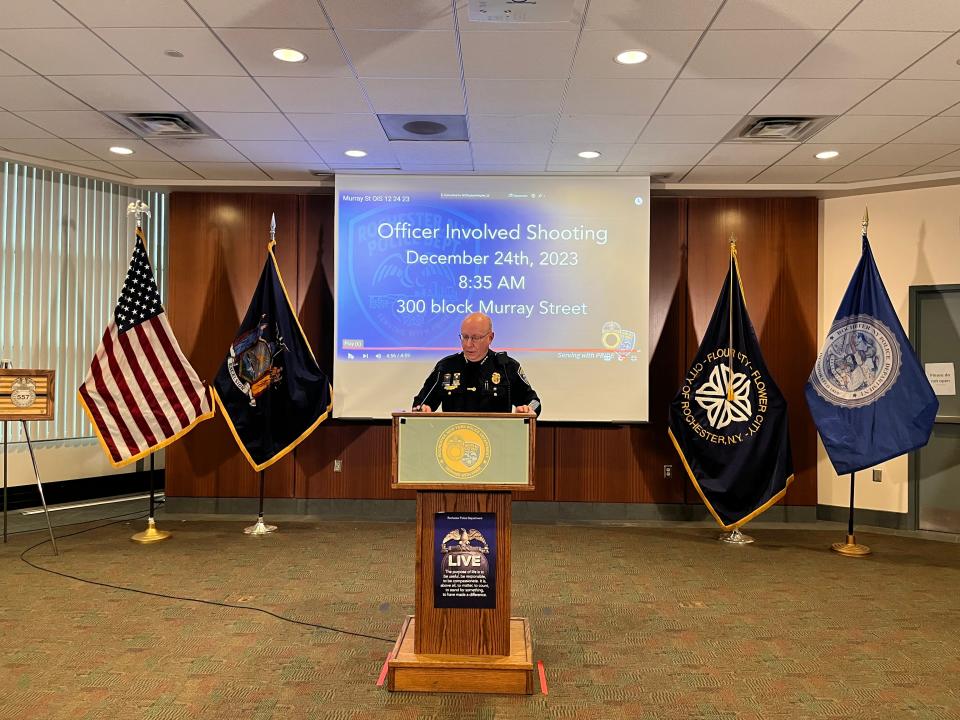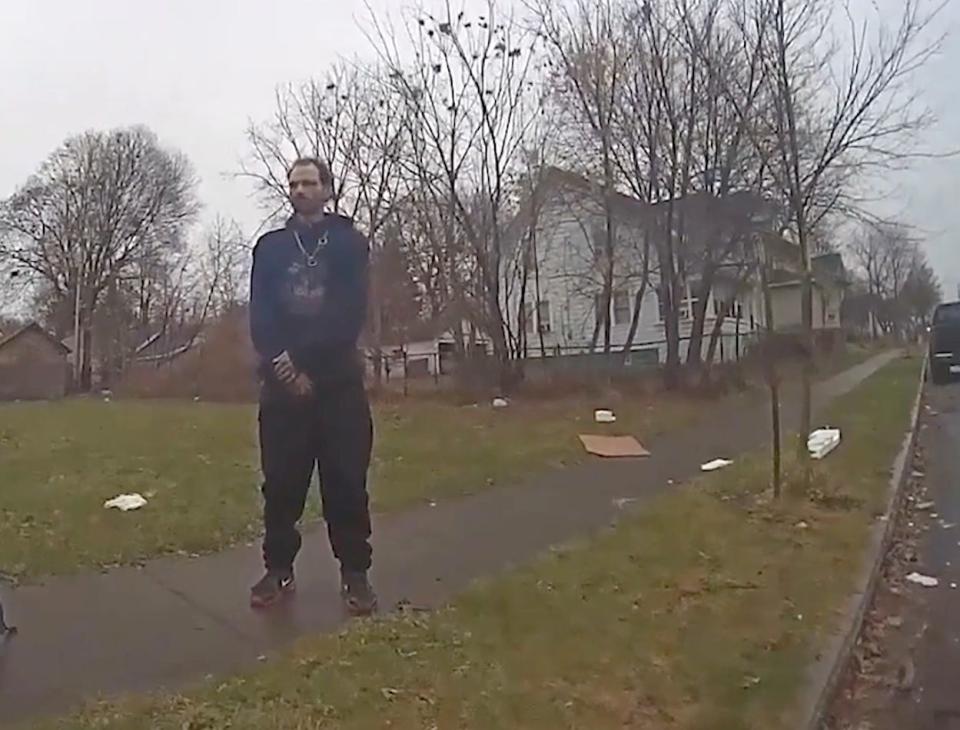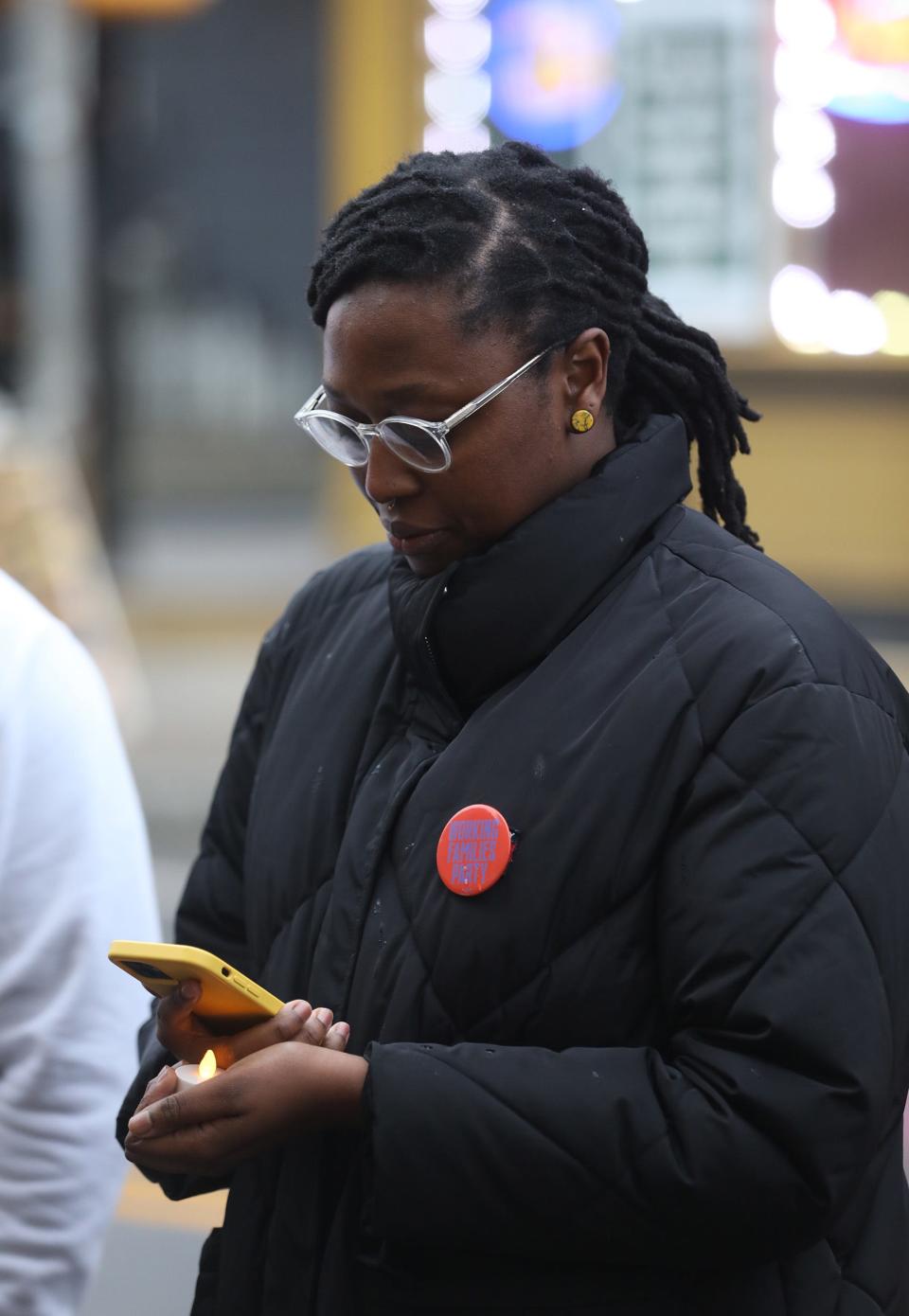Why Rochester police use deadly force against fleeing suspects
A Rochester City police officer shot and killed 46-year-old Todd Novick after he reached for a replica gun in his pocket while fleeing police on Murray Street.
But was he "fleeing?"
Going by the meaning of the English language, yes. Going by RPD perspective, no.
In body-worn camera footage released by police, Novick runs on foot shortly after a second police car arrives on the scene. The responding officer, chasing after him, tells dispatch that Novick is running before yelling twice for the man to stop and once to drop the gun. Five shots in quick succession are fired immediately after the officer’s commands. The entire sequence takes place within seconds.
In press conference two days after the Dec. 24 killing, Rochester City Police Chief David Smith addressed the incident, in which body camera footage showed Novick shot in the back.
Police shot him while he was running away. Novick then complied with police commands after collapsing to the ground.
"When you're running with a gun in your hand, I submit you're not fleeing," Smith said. "You are trying to obtain a better tactical position."
The subject came up again recently. City Council members asked the police chief more questions about the Novick shooting during a Feb. 8 session of the public safety committee. Stanley Martin gave Smith the chance to explain if he meant to say that people aren't fleeing if they are running with their backs to police and have a weapon in their hand.
"Whatever Mr. Novick's intent was, he was running with a gun in his hand," Smith said.
So Novick was running away while trying to drop the gun — and that means he was trying to gain a better tactical position to fire on police, asked Martin?
At this point on the committee's meeting recording, the voice of city counsel can be heard cutting off the chief's potential answer, saying they worried about potential litigation against the city.
The council member then puts some more questions on the record. The discussion never gets back to a final answer on the tactical field question.

How does the Rochester Police Department permit use of force for fleeing suspects?
The Rochester Police Department details its use of force policy in a general order, last updated in January 2023. The policy states the department’s members can only use “force that is objectively reasonable, necessary, and proportional” to effect a “lawful purpose,” including to control a person evading an officer’s lawful commands or prevent escape.
Officers are required to use the least amount of force necessary based on the circumstances and should stop using force once a person is compliant. They must also give verbal commands when it is safe and feasible, and officers should defer using force for a reasonable amount of time to allow the person to comply.
While the policy outlines deadly use of force as a last resort, it does give circumstances when it is permitted. If an officer believes they or another person are in danger of a suspect using deadly physical force or serious physical injury, they can use deadly force such as discharging their firearm.
The policy also specifically outlines circumstances when the use of deadly force to prevent the escape of a fleeing person is permitted. The officer must identify themselves as law enforcement and give a verbal warning if time, safety and circumstances permit.
However, there must also be probable cause that the person has committed or is in the process of committing a felony leading to serious physical injury or death, and the escape of the person would pose an imminent threat to the officer or others if they are not apprehended without delay.
How law enforcement trains for use of force
Law enforcement have to be concerned with their safety, as well as the safety of bystanders and the fleeing suspect, said Shamus Smith, doctoral lecturer of criminology at John Jay College of Criminal Justice. Smith is a former New York Police Department officer and police academy instructor.
To develop best practices, officers are trained in the police academy, refresher courses, and training environments.
“Scenario-based training is probably the best methodology to ensure this,” Smith said. “It’s certainly the most popular amongst recruits and officers in their respective police forces.”
Training generally involves creating scenarios or visual aids to question whether an officer may or may not use deadly force toward a fleeing suspect.
“Even in cases where the suspect has a firearm on their person like a handgun and they’re running away from you,” Shamus Smith said. “ … In this case, if the suspect has his or her back away from you, and they’re running away from you, posing no threat to you as the officer, then you may not shoot.”
If the suspect reaches for what police believe to be a firearm, it can change that decision, however. While it’s not uncommon for suspects to drop a firearm or narcotics when fleeing, the action can be seen as threatening, Smith said.
“If it’s perceived that the suspect fleeing is reaching in their waistband or in their pocket, then they are going to pose a threat, a deadly physical threat, either to you or somebody else, then in that case, the officer may use deadly force,” he said.
Circumstances dictate when an officer is justified in using deadly force, so scenario-based training is best practice to put officers in specific situations, Smith said.

How law enforcement evaluates risk
When officers enter a situation, their view of the situation is influenced by the information they’ve already received from dispatch or other reporting parties, said Bob Harrison, a homeland and national security expert with Rand Corporation and retired law enforcement officer with 30 years of experience.
“The information the officers have, obviously common sense will tell you, that’ll help frame their state of mind,” Harrison said. “And if you’re going into a call and a reporting person has said, ‘Yeah, I think this guy has a gun’ you’re certainly going to be more alert.”
Police academies should address fleeing suspects as part of any deadly force training, Harrison said.
Rochester City Police Chief David Smith played the 911 recording which prompted the officer, who has yet to be identified, to respond to Murray Street during the Dec. 26 news conference. The caller identified two white or Hispanic men in sweatshirts and sweatpants, one with a gun, in what they believed were in their 20s or 30s.
Harrison said he hadn’t considered Smith’s position that fleeing with what the officer believed was a real firearm was obtaining a “better tactical position,” but didn’t disagree.
“That is, in part, why you actually shot a fleeing felon is because if they then can flee, secrete themselves and wait for you, you’re at a significant tactical disadvantage,” Harrison said.
While the 911 call may have led officers to believe Novick had a real gun, he was not being placed under arrest at the time he fled or otherwise detained by the responding officers. The gun was later determined to be a replica gun, most likely a Crosman C11 BB gun based on photos presented during the Dec. 26 press conference.
“BB guns look like firearms. There are toy guns that look very similar to firearms,” Smith said. “At least the way I was trained … you cannot differentiate between what is real and what is not.”
In the Supreme Court’s 1985 decision in Tennessee v. Garner, the court found officers could only use deadly force against a fleeing suspect only if the officer has a good-faith belief the suspect poses threat of death or serious injury to the officer or others.
Police policy was further shaped by Graham v. Connor, which the Supreme Court reviewed in 1989, which required a careful articulation of facts and events prior to a use of force during a stop by officers.
Rochester council members respond to officer-involved shooting
Rochester City Council Vice President Mary Lupien and councilmembers Kim Smith and Stanley Martin released a statement on Dec. 28, expressing condolences to Novick's family and friends.
"It's imperative that we reflect and examine the underlying systemic failures that led to this preventable death, including policies around RPD foot pursuits and sale of realistic toy weapons," the statement said. "To that end, we call on Mayor Evans and Corporation Counsel to work with the Rochester Police Accountability Board to ensure an independent and transparent investigation of the incident ..."
The Rochester Police Locust Club, the officers' union for the Rochester Police Department, issued a statement in response, contesting the characterization of the event.
"The Locust Club members who were involved in this event acted in accordance with their training, RPD policies on the use of deadly force, and both New York and Federal law," the statement said. " ... The suspect’s actions determine the officers’ response. In those instances, our members will perform their duties in strict accordance with their training and the law."

Recent incidents of shootings involving fleeing suspects
A Paterson, New Jersey police officer was indicted Dec. 7 on multiple charges earlier this month after he shot an unarmed man in the back who was running away, paralyzing him, during a June 2022 pursuit. A statement from the New Jersey Attorney General’s office said the officer ordered the victim to drop a gun, but did not order them to stop running or get to the ground; he also did not warn the victim he was going to use deadly force.
Body-worn camera footage did not show the victim possessing or brandishing a firearm, or pointing it at anyone, though a firearm was discovered in the direction he fled.
Surveillance video footage released on Nov. 30 showed a New York Police Department officer shot during an altercation with a suspect after fleeing from police in an April 5 incident. The suspect was involved in an altercation on a bus and when the two responding officers attempted to speak with him, he pushed one and fled on foot.
The NYPD officers eventually caught up to the suspect, with one attempting to grab the suspect, who then shot him in the groin and then pointed the firearm at the other officer before running away again. The other officer fired two shots at the suspect, who was not struck and fled the scene on foot.
More: Man shot by police officer displayed replica gun; identity released
More: Fatal police shooting in Rochester. What we know now
— An earlier version of this story had the incorrect name for someone on first reference but the correct name elsewhere. To be clear: Bob Harrison is a homeland and national security expert with Rand Corporation and retired law enforcement officer with 30 years of experience.
— Steve Howe covers weather, climate and lake issues for the Democrat and Chronicle and his New Year’s resolution is to run more in 2024. Have any insight into changing weather or climate? Share with him at showe@gannett.com.
This article originally appeared on Rochester Democrat and Chronicle: Rochester NY police shooting: Victim wasn't fleeing, chief says

